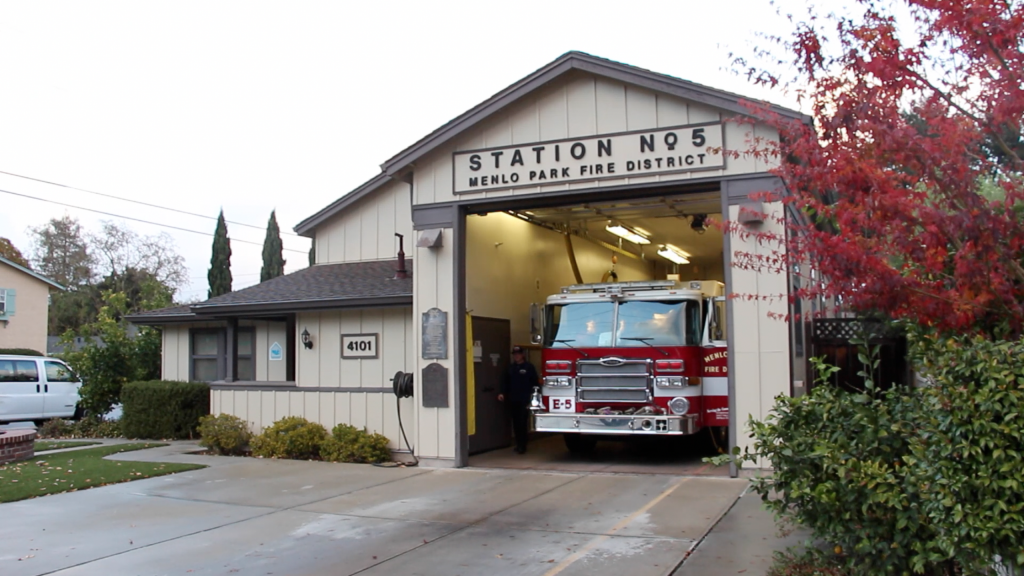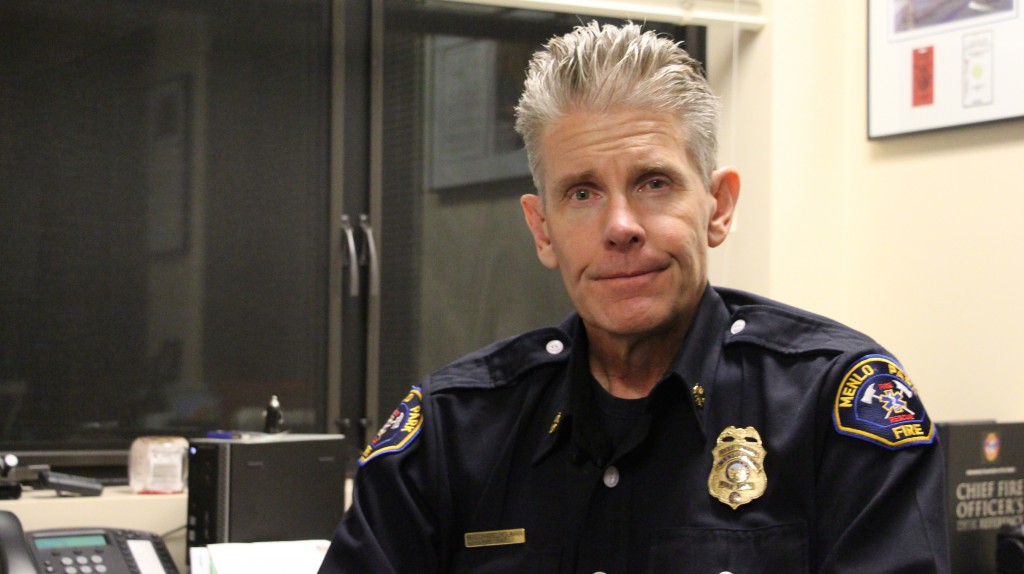There was little to be done by the time they arrived at the accident scene. “Heavy, heavy traffic, absolutely going nowhere,” reported Capt. Seth Johnson as he struggled to find alternate routes to southbound Highway 101, just north of Embarcadero, in San Mateo County. The crew discussed how to quickly transport the victim to nearby Stanford Hospital. Tragically, they never got the chance to execute the agreed-upon plan. Over the radio, the dispatcher pronounced: “patient is in full arrest — not breathing.”
Ronald Barbaran Garcia, 27, died after his motorcycle struck a vehicle at 5:47 p.m. on Sept. 22. A highway patrol officer was the first to arrive, and emergency responders reached the scene more than 10 minutes after the first 911 calls, missing their seven-minute goal by a wide margin.
“We failed to be where we needed to be within a period of time,” Menlo Park Fire Chief Harold Schapelhouman told the San Jose Mercury News on the day of the accident. “Whether that would have made a difference in this incident, I’m not sure.”
The delay experienced by first responders that day wasn’t an exception. The response time for San Mateo County’s emergency personnel arriving at the scenes of accidents, heart attacks and other serious incidents has slowed in recent years, which Schapelhouman said is largely because of inescapable traffic.
Our job is often a race against time and right now, at certain times of the work day, [the delays] are ridiculous and I can’t accept that.
“Our job is often a race against time and right now, at certain times of the work day, [the delays] are ridiculous and I can’t accept that,” Schapelhouman said in an interview earlier this month.
To call the community’s attention to the problem, the Menlo Park Fire Protection District has released a series of dramatic audio and video recordings showing how traffic congestion is snarling emergency vehicles. The District receives fire dispatches from Menlo Park, Atherton, East Palo Alto and unincorporated areas of San Mateo — an estimated population of 90,000.
One of the videos is shot after an Aug. 27 multi-vehicle collision on the Dumbarton Bridge. A dashboard camera shows a fire truck traveling into incoming traffic for six minutes — almost the entire length of East Palo Alto along University Avenue — because of gridlock. The crew took 16 minutes to reach the emergency, where three victims awaited medical attention. You can hear the frustration in the voices of firefighters trying to get to the scene.
“When traffic is as bad as it was that day, we can’t physically get to the patient in a timely manner,” said Battalion Chief Dan Coyle of the occurrence. “Our duty is to show up, make a difference and save lives. When that’s impeded by traffic, it is pretty tragic.” The three victims were taken to the hospital for wounds, all in good condition.
On average, the district responds to 8,200 calls per year. “Many victims are alive today because of our timely response,” Coyle said. They are the reason firefighters adhere so strongly to the motto: “every second counts.” Yet response times have worsened over the last decade, with a significant tipping point in 2014, according to Coyle. “It happens almost every day now. We often have vehicle accidents on the freeway or on the Dumbarton Bridge and we literally can’t get there,” he said.
Despite the use of devices that automatically change traffic signals from red to green, there is no room for firefighters to advance. “We sometimes sit on a [traffic] light watching it turn green, yellow and red three or four times, and we can’t move 10 feet,” Coyle said. Traffic shoulders, when available, are too narrow in many stretches of the road for fire trucks to pass, and cars too often block their path.
As the Peninsula’s economy booms, the situation is expected to worsen. According to the Silicon Valley Institute for Regional Studies, the Menlo Park District alone is projected to grow by nearly 20,000 residents over the next 25 years.
People can’t afford to live here so they drive to get here. The result is that now it takes longer for people to get to hospitals.
For Schapelhouman, the combination of inadequate public transportation and skyrocketing housing prices, which forces people to live further away from work, is the main reason for growing response times. “Until we fix mass transit, until we offer alternatives for people to get out of their cars, traffic will only get busier,” he said. “People can’t afford to live here so they drive to get here. The result is that now it takes longer for people to get to hospitals. They’re backed up at traffic, in ambulances, just as you are.”
Both Schapelhouman and Coyle mentioned Google’s mobile app Waze, which provides alternate routes to escape busy boulevards and packed freeways, as a “huge technological backlash.” With the app, more cars are now using shortcuts through residential neighborhood streets that are not designed to accommodate the volume and speed of cut-through traffic. Routes previously known only to first-responders and used to save critical seconds are now often clogged by new waves of traffic.
Beyond bumper-to-bumper traffic on those streets, the traffic directed by Waze is causing residents to request more calming devices, such as speed bumps, curb extensions and chicanes, which narrow the road so that traffic in one direction has to give way to opposing traffic. While they can help neighborhood traffic, these approaches often make things worse for first responders. “Some of our big trucks can’t get past these devices. People are trying to do things to make themselves feel safer, but by slowing the cars down, they also slow us down,” Coyle said. There are no official efforts to have Waze remove these routes from the app, “just the police department writing a lot of tickets” for careless drivers, Schapelhouman added.
Every minute counts
The firefighters aim to respond to emergencies within seven minutes: one minute for receiving the 911 call; two minutes for the fire crew to get equipment ready and load the truck; and four minutes drive time in the most populated areas.

Such a rigid protocol is especially crucial in medical incidents, which amount to 71 percent of Menlo Park District’s calls. In a heart attack, a respiratory emergency or a trauma that causes severe blood loss, the brain can only live 8-10 minutes without oxygen. A small fire can grow to involve the entire room in the same timeframe. Keeping the response time goal is thus a vital concern for members of the community, who expect that when they make the call for help, it will come quickly.
Fire trucks rush to medical emergencies because of limited resources: in San Mateo County, there are 52 fire engines and 10 ambulances, according to Coyle. “Sometimes we wait for an ambulance to arrive for over 20 minutes,” he said. The firefighters are dual certified as either an emergency medical technician or paramedic, and they are able to stabilize patients while medical personnel is on the way.
The Menlo District is not certain of the number of calls that exceed the time goal, but the increasing number of delays has prompted the fire chief to adopt a monitoring system for all emergencies, closely keeping track of time performance. The results will be reported to the District’s board of directors.
Can roads designed for cars be safe for bikes?
A proposal in Menlo Park to add bike lanes to part of El Camino Real raised concerns for firefighters, as the road is their primary route for emergencies. They believe that the addition of bike lanes will narrow the space for vehicles and further back up traffic.

The city, they argue, is not taking into account the existing Willow Place Bicycle Bridge to Palo Alto and how that route connects with bike lanes on Willow Road, Middlefield, Laurel and Alma Streets. “Are these routes as convenient for bikers to ride on? No, but they’re a heck of a lot safer,” Schapelhouman said. “The last thing I want is to have our people go out and interact with someone who was hit by a vehicle, because typically the cyclist loses. The bigger the vehicle, the worse it is.”
Kristiann Choy, Menlo Park’s senior transportation engineer, believes firefighters wouldn’t be impacted by the change, as most bike lanes will be placed in spaces currently reserved for parking. On stretches without parking space, the city plans to narrow travel lanes. “Still, we wouldn’t go narrower than 10 feet, which fire trucks can maneuver in,” Choy assured. But Schapelhouman isn’t convinced: “All these narrower paths do one thing for response: slow us down,” he said.
Plans to address traffic congestion as a whole seem more inchoate. “We have planned a road transportation study to identify potential solutions for Willow Road that could provide some capacity relief,” Choy said. She doesn’t know when the study will be released, but believes it is “budgeted for this fiscal year.”
Meanwhile, firefighters fear for residents’ safety. “Bad things happen when we can’t get to where we need to go and lives hang in the balance,” Schapelhouman said. “Trust me, if we have a bad day, other people will have a worse day. It may not seem like a huge deal, but, in our world, seconds matter.”
